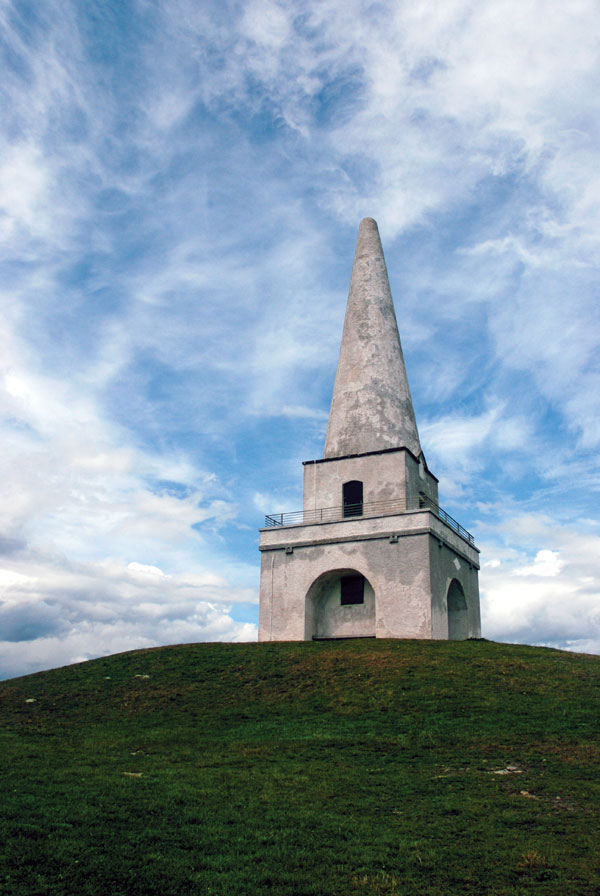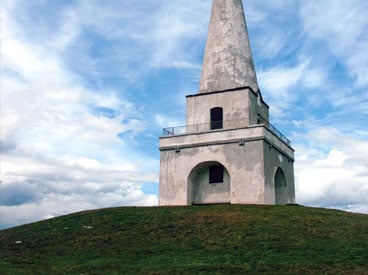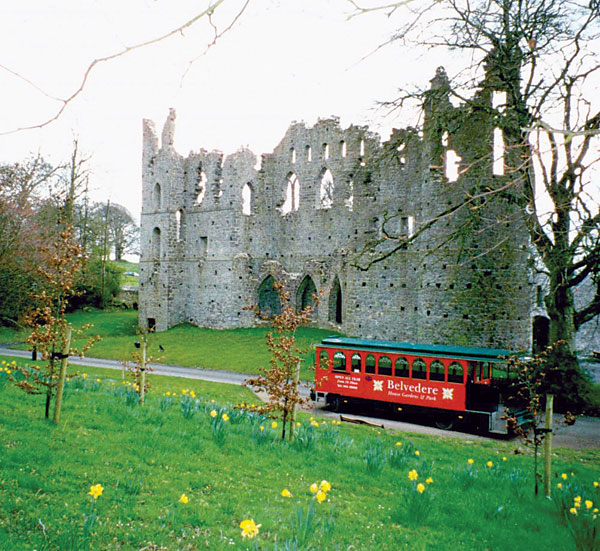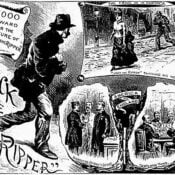Editor’s note: Sally Shivnan’s original story, from which “Ireland’s Follies” in the Sep/Oct 2012 issue was excerpted, is presented here in its entirety for your reading pleasure.
[See Irish Folly Photo Gallery on page 3.]
Walls To Nowhere

Frank and I are staring up at a bunch of immense stone arches stacked artfully together. The same way gymnasts climb onto each other’s shoulders and make a human pyramid of themselves is how these arches are arranged. Out of the top of them rises a single, tall stone spire (like a flagpole the gymnasts might hold up). The arches are a lot bigger than gymnasts unless those gymnasts are giants—together the whole structure is 140 feet high and 100 feet wide. Frank asks me, with absolute puzzlement in his voice, “What is it built for?”
“Nothing,” I reply.
Frank is a trim, middle-aged guy in a nice grey suit, with shiny black shoes. Powder blue shirt and dark blue tie. I’m in pants slopped with stains from two weeks of traveling, and beat-up hiking shoes. Frank and I have only just met, an hour before. “Built for no purpose!” he exclaims. He gets it. I smile at him.
I don’t know much about Frank, except that he is a married father of four, a former investment broker who, since Ireland’s economy tanked, now supports himself driving foreign businessmen to and from the Dublin airport in his small black Mercedes sedan. Traipsing about the countryside in my employ, in search of purposeless buildings, the more purposeless the better for my purposes, is a significant departure from his routine.
I’d already explained about them, when he picked me up at my hotel and asked me what exactly these things were. I gave him a basic definition—odd, sort of pointless structures erected for fun by people who could afford them, often as famine-relief projects to provide work for their tenant farmers. I offered a list—towers, temples, sham castles, obelisks, fake caves; the fake caves were sometimes staffed by fake hermits whose job was to jump out and frighten the party-goers. But a folly in the flesh is worth a thousand words, and standing now before the one called Conolly’s Folly—the massive arrangement of arches and its single, soaring obelisk—Frank is enchanted. He’s hooked.
We are folly hunters. We take off in hot pursuit, Frank refusing to use the SatNav, determined to sniff them out without any help. I explain further, about how they were all the rage in the 18th and 19th centuries among the Irish grand-country-house set, and how I am interested in not just those folks, but in the people who physically built the follies, especially during famine times. I say to Frank, think how they must have felt, building these crazy absurd structures for their uber-wealthy landlords while trying to ignore the hollow gnawing in their stomachs—they would have been grateful for the work, I suppose, but at the same time…
Your ancestors and mine, I want to say to Frank but don’t. Not sure why I don’t—a little self-conscious about playing the Irish heritage card, I suppose. We chat about sports, the economy—Frank resents that he’s lost his business despite never doing anything stupid or irresponsible, unlike the high-rolling greedy people who brought Ireland, and the world, to the state it’s in. He talks about his kids, the eldest just out of college with a degree in marketing, about to emigrate in search of work. These are hungry times again, in their way. We float along in the car, through the green interior of Ireland, past pastures and golf courses, cottages, villages. I notice that the cream-colored leather upholstery of the armrest below my window is scuffed, grubby.
The largest folly in Ireland is the Jealous Wall, and the story behind it is as marvelous and creepy as its name. It starts in 1740 with Robert Rochfort building a big house on a lake. He suspects his wife of cheating on him with his brother, so he confines her to his other house where she has no contact with the outside world for 31 years. She has to walk around with a servant ringing a bell when her husband visits so he can avoid running into her. But these visits are rare, as he spends most of his time at his estate on the lake, where another of his brothers—by all accounts an instigator of the adultery rumors and by this time not someone Robert is fond of—starts building an even bigger house of his own just half a mile from Robert’s property line. It’s situated to block Robert’s best view, and, as a final snub, it is turned away from Robert’s house, its rear end, so to speak, in Robert’s face.
So Robert builds a wall. A freestanding, three-story, 180-foot-long pseudo-crumbling Gothic wall-to-nowhere incorporating curves, corners, a half-turret at one end, and numerous arched, rounded, and square window openings and doorways. Now when he looks out from his house, he sees this wall, rather than his brother’s place. It’s a compromise. It has its parallel in the way he imprisons his wife since he cannot go back in time with her to the way things were before.
Whether she had the affair she was accused of has been debated and will never be known. When Robert died, age 66, they came to let her go. The first words of the poor half-mad woman, who at this point couldn’t speak above a shrill whisper, were “Is the tyrant dead?”
The Jealous Wall was not built for famine-relief but for rage relief. Many follies were built during periods of famine, though, including that huge pile of arches, Conolly’s Folly. In some places you can find follies built during the Great Famine of the 1840s standing alongside others built during the less well known but equally devastating famine of the 1740s, which killed nearly 40 percent of the Irish population. At these sites you might find no follies from the intervening hundred years, however, as if the folly-building urge hit only once a century, triggered by tragedy. The whimsical nature of follies, under the circumstances, seems more than a little bizarre, and this incongruity is, I know, a big part of what drives my curiosity.
One such place, with follies separated by the century between the two famines, is Killiney, half an hour south of Dublin. I took the train there, much of the way running right along the strand around Dublin Bay, the fishing boats and pleasure boats like toys bobbing on the glittery blue water. When I stepped from the train and looked up to the hilltop above the village, I saw the funny, pointy cone of the oldest of the Killiney follies—a white-cement dunce-cap sticking out of a blocky little building, crowning the steep, wooded hill. I started walking up, along lanes that snaked between high stone walls concealing the country homes of the new gentry—Irish celebrities of the sort who go by one name, Bono, Enya—and after a half-hour climb I stepped from the shade of oaks and beeches into sunlight and a wide expanse of grass, and I beheld the folly’s weird white cone poking up into a blue-and-cloudy sky. A marble plaque embedded in the wall beneath the cone reads:
LAST year being
hard with the POOR
the Walls about these
HILLS and THIS
erected by
JOHN MAPAS
Esq. June 1742
Mr. Mapas seems not to have known what to call the thing he’d built and the best he could come up with was “THIS.” His THIS commands a view to the east of the Irish Sea, and to the south the picture-postcard sweep of Killiney Bay and beyond it the Wicklow mountains, friendly and pastoral-looking. Other follies share the hilltop: a second, smaller cone-topped structure called the Witch’s Hat, a miniature stepped pyramid about 15 feet tall that kids can clamber up, and a couple of spooky stone-slab structures that look like ancient sarcophagi, these all built a hundred years later, during the next terrible famine. Even though I should have known better, I acted just like Frank when I saw those pseudo-sarcophagi—I couldn’t help myself, I had to ask what they were for. Seriously—a pair of austere, somber, fake stone tombs sitting in the middle of the grass all by themselves? I stopped a guy who looked like he’d know; he was riding around in a golf-cart spearing rubbish on a stick. A cigarette dangled from his lip as he worked, and he looked gruff and Irish.
“They’re follies,” he said.
I knew that. “What were these for?”
“Place to ‘ave their tea on!” he called out, spearing a Fanta bottle. “They’re all follies! Buildings built for no purpose!” And he hopped in his buggy and putt-putted away.
John Mapas’s estate, where he built the cone he called THIS in 1742, belonged to a different owner just thirteen years later, and it changed hands three more times before the Great Famine of the 1840s spurred the second round of folly-building there. Today, the mansion that Mapas built, and which later owners expanded, is a four-star hotel that showed a modest operating profit in 2010 but had a loss of €340,000, mostly in bank loan payments. Its total loss on paper for the year, however, was €8 million, the result of writing down the value of the property by €7.9 million. Irish real estate is not doing well. The word folly has many shades of meaning.
It was typical for these houses to change hands a lot, as the Killiney estate did. And Ireland is littered with the ruins of abandoned grand country homes—roofless shells overrun with ivy, gardens gone to grass and thistle. These greatly outnumber the ones that survived as hotels, golf courses, and public parks. Their owners went bankrupt, or simply fled, many impoverished by famine along with their tenants. Famine meant the collapse of the rural economy, on which the landlords depended; they lost the rents from their tenants, the basis of their wealth. There’s a certain ironic karma in the ruin of these landowners by famine, though, since famine was largely the result of poverty, and poverty was caused by injustice and inequality, and injustice and inequality were the products of the feudal system that put Irish land in the hands of the privileged few. In 1849, during the Great Famine, the Encumbered Estates Court was established to deal with all the bankruptcies, and in the decade that followed, 8000 of these properties changed hands. Other landlords moved on when land reform broke up the large estates around the end of the 19th century, or a few years later during the Irish War of Independence. In some cases, the formerly landless farmers were content to stand back and watch the huge, empty houses rot, while in other cases, they burned the places down.
We think of the conflict as between the Irish Protestant ruling class and the Catholic majority, but this oversimplifies it, because there were “dissenter” Protestants in sects that were discriminated against just as Catholics were, and there were Catholic landowners who acquired Protestant holdings during certain periods, and there were Catholics who had once been Protestants but who changed religious affiliation hundreds of years back. There were, as well, Irish Protestant aristocrats who were as passionate about the cause of Irish independence as any Catholic. The lines get blurred, even if you leave out the occasional, inevitable unsanctioned encounter between wealthy landlord and peasant serving girl. Anywhere you go in the Republic of Ireland you find both Gaelic and Anglo surnames, though all these folks are Irish, and mostly Catholic. Irish people’s ancestry is a complicated mix, as is true for all humans, and the Irish are walking around with the DNA of the colonizers, as well as the colonized, inside them.
Become a Saturday Evening Post member and enjoy unlimited access. Subscribe now





Comments
Two years ago, we were at the Orlando Airportdeparture gate, awaiting take-off for Ireland, my grandfather and grandmother’s birthplace. And then the volcano erupted again. Events have prevented us from rescheduling the trip, and I’m so glad. The article about Ireland’s Follies is wonderful and stirs the wanderlust. We are now researching – again- all the things we want to see in Ireland, and we have added the Follies to our must-see list. Thank you for making us aware of these; we can hardly wait to go.
LOVED your article on the Follies of Ireland. Just made me want to drop everything and go. Thanks for a Follie good time